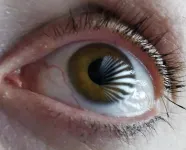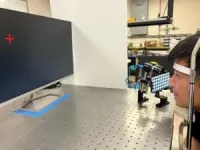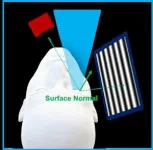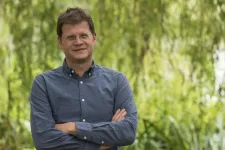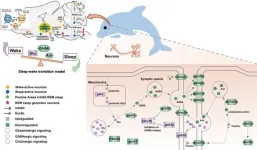(Press-News.org) Eye tracking plays a critical role in the latest virtual and augmented reality headsets and is an important technology in the entertainment industry, scientific research, medical and behavioral sciences, automotive driving assistance and industrial engineering. Tracking the movements of the human eye with high accuracy, however, is a daunting challenge.
Researchers at the University of Arizona Wyant College of Optical Sciences have now demonstrated an innovative approach that could revolutionize eye-tracking applications. Their study, published in Nature Communications, finds that integrating a powerful 3D imaging technique known as deflectometry with advanced computation has the potential to significantly improve state-of-the-art eye tracking technology.
"Current eye-tracking methods can only capture directional information of the eyeball from a few sparse surface points, about a dozen at most," said Florian Willomitzer, associate professor of optical sciences and principal investigator of the study. "With our deflectometry-based method, we can use the information from more than 40,000 surface points, theoretically even millions, all extracted from only one single, instantaneous camera image."
"More data points provide more information that can be potentially used to significantly increase the accuracy of the gaze direction estimation," said Jiazhang Wang, postdoctoral researcher in Willomitzer's lab and the study's first author. "This is critical, for instance, to enable next-generation applications in virtual reality. We have shown that our method can easily increase the number of acquired data points by a factor of more than 3,000, compared to conventional approaches."
Deflectometry is a 3D imaging technique that allows for the measurement of reflective surfaces with very high accuracy. Common applications of deflectometry include scanning large telescope mirrors or other high-performance optics for the slightest imperfections or deviations from their prescribed shape.
Leveraging the power of deflectometry for applications outside the inspection of industrial surfaces is a major research focus of Willomitzer's research group in the U of A Computational 3D Imaging and Measurement Lab. The team pairs deflectometry with advanced computational methods typically used in computer vision research. The resulting research track, which Willomitzer calls "computational deflectometry," includes techniques for the analysis of paintings and artworks, tablet-based 3D imaging methods to measure the shape of skin lesions, and eye tracking.
"The unique combination of precise measurement techniques and advanced computation allows machines to 'see the unseen,' giving them 'superhuman vision' beyond the limits of what humans can perceive," Willomitzer said.
In this study, the team conducted experiments with human participants and a realistic, artificial eye model. The team measured the study subjects' viewing direction and was able to track their gaze direction with accuracies between 0.46 and 0.97 degrees. When tested on the artificial eye model, the error was around just 0.1 degrees.
Instead of depending on a few infrared point light sources to acquire information from eye surface reflections, the new method uses a screen displaying known structured light patterns as the illumination source. Each of the more than 1 million pixels on the screen can thereby act as an individual point light source.
By analyzing the deformation of the displayed patterns as they reflect off the eye surface, the researchers can obtain accurate and dense 3D surface data from both the cornea, which overlays the pupil, and the white area around the pupil, known as the sclera, Wang explained.
"Our computational reconstruction then uses this surface data together with known geometrical constraints about the eye's optical axis to accurately predict the gaze direction," he said.
In a previous study, the team has already explored how the technology could seamlessly integrate with virtual reality and augmented reality systems by potentially using a fixed embedded pattern in the headset frame or the visual content of the headset itself – be it still images or video –as the pattern that is reflected from the eye surface. This can significantly reduce system complexity, the researchers say. Moreover, future versions of this technology could use infrared light instead of visible light, allowing the system to operate without distracting users with visible patterns.
"To obtain as much direction information as possible from the eye's cornea and sclera without any ambiguities, we use stereo-deflectometry paired with novel surface optimization algorithms," Wang said. "The technique determines the gaze without making strong assumptions about the shape or surface of the eye, as some other methods do, because these parameters can vary from user to user."
In a desirable "side effect," the new technology creates a dense and accurate surface reconstruction of the eye, which could potentially be used for on-the-fly diagnosis and correction of specific eye disorders in the future, the researchers added.
Aiming for the next technology leap
While this is the first time deflectometry has been used for eye tracking – to the researchers' knowledge – Wang said, "It is encouraging that our early implementation has already demonstrated accuracy comparable to or better than commercial eye-tracking systems in real human eye experiments."
With a pending patent and plans for commercialization through Tech Launch Arizona, the research paves the way for a new era of robust and accurate eye-tracking. The researchers believe that with further engineering refinements and algorithmic optimizations, they can push the limits of eye tracking beyond what has been previously achieved using techniques fit for real-world application settings. Next, the team plans to embed other 3D reconstruction methods into the system and take advantage of artificial intelligence to further improve the technique.
"Our goal is to close in on the 0.1-degree accuracy levels obtained with the model eye experiments," Willomitzer said. "We hope that our new method will enable a new wave of next-generation eye tracking technology, including other applications such as neuroscience research and psychology."
Co-authors on the paper include Oliver Cossairt, adjunct associate professor of electrical and computer engineering at Northwestern University, where Willomitzer and Wang started the project, and Tianfu Wang and Bingjie Xu, both former students at Northwestern.
END
New 3D technology paves way for next-generation eye-tracking
By integrating powerful 3D imaging technology with advanced computation, University of Arizona researchers can capture gaze direction information from tens of thousands of surface points on the eye instead of the dozen or so used by conventional eye-track
2025-04-01
ELSE PRESS RELEASES FROM THIS DATE:
Diagnosing a dud may lead to a better battery
2025-04-01
It’s (going to be) electric.
But how soon? How quickly our society can maximize the benefit of electrification hinges on finding cheaper, higher performance batteries — a reality closer to hand through new research from Virginia Tech.
A team of chemists led by Feng Lin and Louis Madsen found a way to see into battery interfaces, which are tight, tricky spots buried deep inside the cell. The research findings were published on April 1 in the journal Nature Nanotechnology.
“There are major, longstanding challenges at the interfaces,” ...
We know nanoplastics are a threat—this new tool can help us figure out just how bad they are
2025-04-01
April 1, 2025
AMHERST, Mass. – While the threat that microplastics pose to human and ecological health has been richly documented and is well known, nanoplastics, which are smaller than one micrometer (1/50th the thickness of an average human hair), are far more reactive, far more mobile and vastly more capable of crossing biological membranes. Yet, because they are so tiny and so mobile, researchers don’t yet have an accurate understanding of just how toxic these particles are. The first step to understanding the toxicology of nanoplastics is to build a reliable, ...
Mpox could become a serious global threat, scientists warn
2025-04-01
Mpox has the potential to become a significant global health threat if taken too lightly, according to scientists at the University of Surrey.
In a letter published in Nature Medicine, researchers highlight how mpox – traditionally spread from animals to humans – is now showing clear signs of sustained human-to-human transmission.
Mpox is a viral infection caused by a virus that belongs to the same family as smallpox. The virus can cause a painful rash, fever, and swollen glands and, in some cases, lead to more serious illness. Mpox usually spreads through ...
Combination immunotherapy shrank a variety of metastatic gastrointestinal cancers
2025-04-01
A new form of tumor infiltrating lymphocyte (TIL) therapy, a form of personalized cancer immunotherapy, dramatically improved the treatment’s effectiveness in patients with metastatic gastrointestinal cancers, according to results of a clinical trial led by researchers at the National Institutes of Health (NIH). The findings, published April 1, 2025 in Nature Medicine, offer hope that this therapy could be used to treat a variety of solid tumors, which has so far eluded researchers developing cell-based ...
Newborn warty birch caterpillars defend the world’s smallest territory
2025-04-01
Real estate is precious. Some creatures defend territories extending over several kilometres, but when Jayne Yack (Carleton University, Canada) encountered miniature newborn warty birch caterpillars (Falcaria bilineata) she wondered if she might have discovered one of the world’s smallest, and youngest, territorial critters. ‘We had noticed that tiny warty birch caterpillars produced vibrations’, says Yack, who first encountered the feisty little creatures in 2008. She also noticed that the tiny caterpillars – 1 to 2 mm long – reside in solitude on birch leaves, making her speculate whether they ...
Exposure to air pollution in childhood is associated with reduced brain connectivity
2025-04-01
A new study led by the Barcelona Institute for Global Health (ISGlobal), a centre supported by the "la Caixa" Foundation, has found that children exposed to higher levels of air pollution in early and mid childhood have weaker connections between key brain regions. The findings, published in Environment International, highlight the potential impact of early exposure to air pollution on brain development.
The research showed reduced functional connectivity within and between certain cortical and subcortical brain networks. These networks are systems of interconnected brain structures that work together to perform different cognitive functions, such as thinking, perceiving and controlling ...
Researchers develop test using machine learning to help predict immunotherapy response in lymphoma patients
2025-04-01
LOS ANGELES — Researchers with City of Hope, one of the largest and most advanced cancer research and treatment organizations in the United States, with its National Medical Center in Los Angeles ranked among the nation’s top 5 cancer centers by U.S. News & World Report, and MSK have created a tool that uses machine learning to assess a non-Hodgkin lymphoma (NHL) patient’s likely response to chimeric antigen receptor (CAR) T cell therapy before starting the treatment, according to study results published today in Nature Medicine.
CAR T cell therapy ...
New UNSW research reveals dramatically higher loss of GDP under 4°C warming
2025-04-01
New projections by the UNSW Institute for Climate Risk & Response (ICRR) reveal a 4°C rise in global temperatures would cut world GDP by around 40% by 2100 – a stark increase from previous estimates of around 11%.
The recently-published analysis fixes an oversight in the current economic model underpinning global climate policy, toppling previous carbon benchmarks.
The results support limiting global warming to 1.7 °C, which is in line with significantly faster decarbonisation goals like the Paris Agreement, and far lower than the 2.7°C supported ...
Discovery of Quina technology challenges view of ancient human development in East Asia
2025-03-31
While the Middle Paleolithic period is viewed as a dynamic time in European and African history, it is commonly considered a static period in East Asia. New research from the University of Washington challenges that perception.
Researchers discovered a complete Quina technological system — a method for making a set of tools — in the Longtan site in southwest China, which has been dated to about 50,000 to 60,000 years ago. Quina technology was found in Europe decades ago but has never before been found in East Asia.
The team published its findings March ...
Whales and dolphins sleep by turning off one half of their brains at a time; scientists discover more about the genes and pathways that enable this phenomenon
2025-03-31
Whales and dolphins sleep by turning off one half of their brains at a time; scientists discover more about the genes and pathways that enable this phenomenon.
####
Article URL: https://plos.io/4c9g5gm
Article Title: Evolution of canonical circadian clock genes underlies unique sleep strategies of marine mammals for secondary aquatic adaptation
Author Countries: China
Funding: This work was supported by the National Key Research and Development (R&D) Program of China (grant no. 2022YFF1301600) to G.Y. & S.X., the Key Project ...
LAST 30 PRESS RELEASES:
Making lighter work of calculating fluid and heat flow
Normalizing blood sugar can halve heart attack risk
Lowering blood sugar cuts heart attack risk in people with prediabetes
Study links genetic variants to risk of blinding eye disease in premature infants
Non-opioid ‘pain sponge’ therapy halts cartilage degeneration and relieves chronic pain
AI can pick up cultural values by mimicking how kids learn
China’s ecological redlines offer fast track to 30 x 30 global conservation goal
Invisible indoor threats: emerging household contaminants and their growing risks to human health
Adding antibody treatment to chemo boosts outcomes for children with rare cancer
Germline pathogenic variants among women without a history of breast cancer
Tanning beds triple melanoma risk, potentially causing broad DNA damage
Unique bond identified as key to viral infection speed
Indoor tanning makes youthful skin much older on a genetic level
Mouse model sheds new light on the causes and potential solutions to human GI problems linked to muscular dystrophy
The Journal of Nuclear Medicine ahead-of-print tip sheet: December 12, 2025
Smarter tools for peering into the microscopic world
Applications open for funding to conduct research in the Kinsey Institute archives
Global measure underestimates the severity of food insecurity
Child survivors of critical illness are missing out on timely follow up care
Risk-based vs annual breast cancer screening / the WISDOM randomized clinical trial
University of Toronto launches Electric Vehicle Innovation Ontario to accelerate advanced EV technologies and build Canada’s innovation advantage
Early relapse predicts poor outcomes in aggressive blood cancer
American College of Lifestyle Medicine applauds two CMS models aligned with lifestyle medicine practice and reimbursement
Clinical trial finds cannabis use not a barrier to quitting nicotine vaping
Supplemental nutrition assistance program policies and food insecurity
Switching immune cells to “night mode” could limit damage after a heart attack, study suggests
URI-based Global RIghts Project report spotlights continued troubling trends in worldwide inhumane treatment
Neutrophils are less aggressive at night, explaining why nighttime heart attacks cause less damage than daytime events
Menopausal hormone therapy may not pose breast cancer risk for women with BRCA mutations
Mobile health tool may improve quality of life for adolescent and young adult breast cancer survivors
[Press-News.org] New 3D technology paves way for next-generation eye-trackingBy integrating powerful 3D imaging technology with advanced computation, University of Arizona researchers can capture gaze direction information from tens of thousands of surface points on the eye instead of the dozen or so used by conventional eye-track
